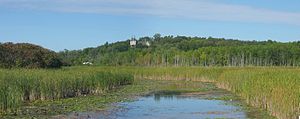Definition Of Marsh
A marsh is a wetland that is ruled by herbaceous instead of woody plant species. Bogs can regularly be found at the edges of lakes and streams, where they structure a change between the oceanic and earthbound biological communities. They are regularly ruled by grasses, surges or reeds. On the off chance that woody plants are available they will in general be low-developing bushes. This type of vegetation is the thing that separates bogs from different kinds of wetland, for example, swamps, which are ruled by trees, and mires, which are wetlands that have collected stores of acidic peat.
Marshes provide a habitat for many species of plants, animals, and insects that have adapted to living in flooded conditions. The plants must be able to survive in wet mud with low oxygen levels. Many of these plants therefore have aerenchyma, channels within the stem that allow air to move from the leaves into the rooting zone. Marsh plants also tend to have rhizomes for underground storage and reproduction. Familiar examples include cattails, sedges, papyrus and sawgrass. Aquatic animals, from fish to salamanders, are generally able to live with a low amount of oxygen in the water. Some can obtain oxygen from the air instead, while others can live indefinitely in conditions of low oxygen. Marshes provide habitats for many kinds of invertebrates, fish, amphibians, waterfowl and aquatic mammals. Marshes have extremely high levels of biological production, some of the highest in the world, and therefore are important in supporting fisheries.Marshes also improve water quality by acting as a sink to filter pollutants and sediment from the water that flows through them. Marshes (and other wetlands) are able to absorb water during periods of heavy rainfall and slowly release it into waterways and therefore reduce the magnitude of flooding. The pH in marshes tends to be neutral to alkaline, as opposed to bogs, where peat accumulates under more acid conditions.














No comments:
Post a Comment